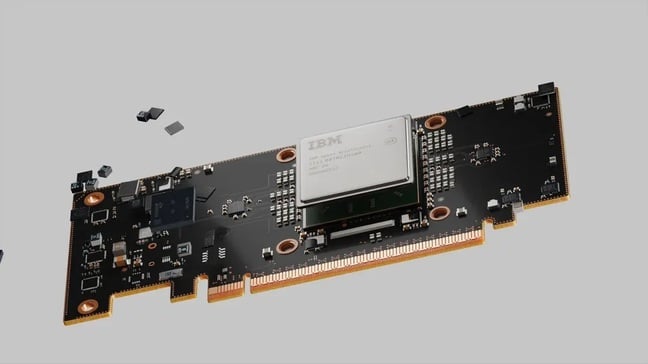IBM's Spyre Accelerator is set to be generally available later this month, delivering a boost to the AI capabilities of its enterprise-grade hardware including the z17 mainframe, LinuxONE 5, and Power11 systems.
Spyre, described by Big Blue as an accelerator purpose-built to handle the demands of AI processing, will be generally available from October 28 for IBM z17 and LinuxONE 5 systems, and in early December for Power11 servers.
The hardware was announced earlier this year alongside the z17, IBM's latest mainframe incarnation. It is a PCIe card based on a custom chip with 32 individual accelerator cores, understood to be a similar architecture to the AI accelerator hardware embedded in the Telum II processors that power the z17.
Its intended purpose is to allow AI processing to scale to meet whatever requirements the customer may have for one of IBM's enterprise systems, which typically includes fraud detection checks against financial transactions, but generative AI and large language models (LLMs) may now be a feature in the workload mix.
For this reason, it is possible to configure a cluster of up to 48 Spyre cards in an IBM Z or LinuxONE system, or up to 16 cards in a Power system.
"One of our key priorities has been advancing infrastructure to meet the demands of new and emerging AI workloads," said chief operating officer for IBM Infrastructure, Barry Baker.
"With the Spyre Accelerator, we're extending the capabilities of our systems to support multi-model AI – including generative and agentic AI. This innovation positions clients to scale their AI-enabled mission-critical workloads with uncompromising security, resilience, and efficiency, while unlocking the value of their enterprise data."
Multi-model (NOT multi-modal) refers to the use of multiple models to improve accuracy and reduce false positives, when performing inferencing work.
- IBM invites CockroachDB to infest its mainframes with PostgreSQL
- Irony alert: UK.gov Work dept hires IBM to aid AI projects
- IBM killing mainframe coding kit for PCs this year
- Red Hat back-office team to be Big and Blue whether they like it or not
IBM claimed, at the z17 launch, that it was seeing a trend emerging of combining both the strengths of predictive AI with the strengths of LLMs to extract new features or new insights, to get better or more accurate results, for example.
Mike Chuba, Managing VP in Gartner's Infrastructure and Operations group, told us at the time that IBM had put a lot more effort into understanding and supporting what its mainframe customers wanted.
"IBM's R&D efforts now focus on how the new hardware directly addresses the challenges its customers are facing. The focus on AI with the dedicated accelerator they introduced on the z16 and the turbocharged Version 2 coming with this generation directly addresses, for example, the challenge of fraud detection at the point of the transaction."
At the end of September, Big Blue also released z/OS 3.2, the latest build of its mainframe operating system. This brings support for the AI accelerator tech in the z17, and it also has features to make z/OS data accessible in hybrid cloud and AI environments without resorting to Extract-Transform-Load (ETL) processes.
IBM previously stated that this release would add support for modern data access methods, and NoSQL databases, to allow AI to tap into a broader set of enterprise data from which to apply predictive business insights.
The other systems that could get some benefit from the Spyre Accelerator are the latest LinuxONE model, which is powered by the same Telum II processor as the z17, but runs only Linux; and Power11 systems such as the Power E1180, which can be configured with up to 256 cores. ®
.png)





